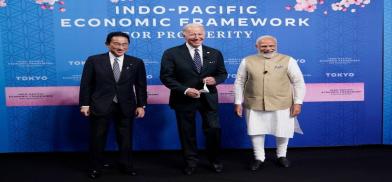IPEF: A challenge and opportunity in the Indo-Pacific region
Since the US is not a member of RCEP, the collaborative approach of the US and India will pose a big challenge to RCEP, which falls under Chinese influence, writes S. Majumder for South Asia Monitor

With the launch of the Indo-Pacific Economic Framework (IPEF), a new window was opened for India for economic partnership and trade expansion in the Indo-Pacific region. Major trading partners of India in South East Asia are signatories to IPEF and are also part of the Regional Cooperation for Economic Partnership (RCEP), from which India withdrew in 2019.
Undoubtedly, IPEF is a brainchild of the United States to regain influence in the Indo-Pacific region and as a countermeasure to China’s growing geopolitical and geo-economic clout. IPEF is an extension of Quad -- a security arrangement between the US, Japan, India and Australia – to reinforce Washington’s Indo-Pacific strategy.
But while the strategic aim behind IPEF is to resist China’s influence in the region, most South Asian nations in IPEF have FTAs with China, either through ASEAN-China FTA or RCEP. This makes one wonder how IPEF can help the US succeed in its Indo-Pacific strategy.
India and IPEF
The 13 nations in IPEF are the US, India, Japan, South Korea, Australia, New Zealand, Singapore, Vietnam, Thailand, Indonesia, Malaysia, the Philippines and Brunei. Together, they account for 40 percent of world trade and 60 percent of the global population.
IPEF will focus on three pillars – connected economy, resilient economy and free economy. The connected economy will pursue for high standards of digital economy such as cross-border data flows and data localization, increased opportunities for SMEs to reap benefits from e-commerce; resilient economy refers to seeking commitment for price stabilization for supply chain among the members; and free economy will seek a commitment for fair taxation system, stringent regulations for anti–monetary laundering and anti-bribery arrangements.
However, IPEF skipped the issue of FTA. Arguably, this might be a hindrance to the interests of South-East Asian nations which are already engaged in FTAs with China, according to James Crabtree of the Singapore International Institute for Strategic Studies.
Besides, there are other issues. One is the absence of a dispute settlement mechanism. Given this, how will disputes related to compliance of the three pillars be settled? Also, in the absence of China and its allies like Cambodia, Laos and Myanmar, the trajectory of decision making will be US-oriented.
Taking on China
Nevertheless, the involvement of a large number of South East Asian nations and countermeasure to China sent a positive signal for India to be a signatory to IPEF irrespective of the absence of FTA or guaranteed practical benefits.
For India, the significance of a 13-nation economic club harps on its larger share in India’s global trade. IPEF accounted for nearly 30 percent of India’s global trade in 2020-21, comprising of 32. 8 percent in exports and 27.4 percent in imports. The US is the biggest trading partner, followed by Singapore, Indonesia, South Korea and Japan.
Another observation is that Vietnam is emerging as a best possible alternative to China in supply chain. It has emerged as the second-biggest import destination for critical imports of electronic items for India after China.
There are three benefits which can stem from IPEF.
First, India’s entry into IPEF will accelerate its Act East policy. There are nine countries from South East Asia among 13 IPEF members. The main aim of Act East Policy, introduced in 2014, was to promote economic cooperation, cultural ties and develop strategic relations with countries the Asia-Pacific region, thereby providing enough connectivity to India’s northeast region.
Pro-India sentiment
Strong pro-India sentiment was built up in South-East Asia with India’s unique financial management to insulate itself from the global financial crisis in 2008-09. And India was recognized as a strong defiant to China’s growing authority in the region. But the sentiment waned with India’s withdrawal from RCEP.
With the launching of IPEF, India re-emerged as a force to counter China in the region. This will pave the way for the re-emergence of pro-India sentiment as India’s defiance against China will intensify with the support of the US and Japan.
Second, India is a digital power house. India is the second largest digitized economy among 17 leading economies, according to a McKinsey survey. It has more than half a billion Internet users. It constitutes nearly 1.2 billion mobile phone subscribers and 14 percent of total apps installations in the world.
India’s digital power will help the development of e-retailing and banking services, widening education facilities, delivery, factory inventory systems and job creation in IPEF member nations. Countries like Thailand, Vietnam, Indonesia and Singapore, which are large trading partners of India in IPEF, will open opportunities for India’s service trade in digitization in these countries.
India and Vietnam
Third, India’s aspiration to be a global hub for supply chain will get a boost. There was a dramatic change in global supply chain trend post Covid-19. It has been re-worked, with a shift from low cost making nations to risk aversion sources. Eventually, India and Vietnam emerged as the best options for alternatives to China.
India, with the power of digitization, is one step ahead of Vietnam to be considered a hub for supply chain in the Indo-Pacific region.
IPEF will help India to unearth new opportunities in the Indo-Pacific region. Since the US is the biggest trading partner of India and the major foreign investor, Washington’s leadership will leverage more opportunities in the region. Since the US is not a member of RCEP, the collaborative approach of the US and India will pose a big challenge to RCEP, which falls under Chinese influence.
(The writer is a former Adviser, Japan External Trade Organization, New Delhi. Views are personal.)




Post a Comment